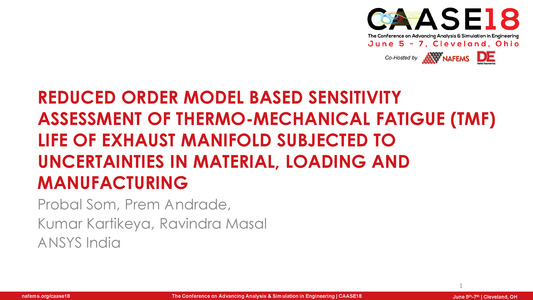
This presentation was made at CAASE18, The Conference on Advancing Analysis & Simulation in Engineering. CAASE18 brought together the leading visionaries, developers, and practitioners of CAE-related technologies in an open forum, to share experiences, discuss relevant trends, discover common themes, and explore future issues.
Resource Abstract
A need for higher efficiency in Power and Transportation sector is leading to increased range of temperature in several components like the cylinder head, exhaust manifold, turbocharger etc. Predicting low cycle fatigue failures, such as Thermo-Mechanical Fatigue (TMF), due to high thermal and mechanical loading is critical across the industry segments. TMF failure prediction requires accurate material characterization of relatively new materials like heat resistant alloys, which includes understanding the material behavior across temperature, strain rates, strain ranges and hold times. Also, for fatigue life estimation through simulations, traditional stress or strain based life calculation approaches can lead to false positives. Typically, an exhaust manifold undergoes fatigue, creep, oxidation etc. under high thermo-mechanical loading and accurate life prediction requires consideration of interplay between stress, strain and their orientations. A widely used simulation technique, which takes this into account, is the Crack Tip Opening Displacement (CTOD) based life prediction. This approach has been predominantly used by industries, but the predictability is often under question due to the uncertainties in inputs required for these calculations. These uncertainties vary from manufacturing tolerance, material variance, material curve fitting errors, loading variance and so on. The present study on an exhaust manifold attempts to take these uncertainties into account in a computationally effective manner. At the top level of the study, uncertainty in thickness distribution from casting process of manifold is addressed using a spectral decomposition based Reduced Order Modeling (ROM) technique. ROM based technique can quickly capture the randomness in thickness change coming out of casting process at different locations of the manifold geometry. It can update the nominal mesh to replicate any random thickness shape within the manufacturing tolerance. Finally, a variance based sensitivity analysis is performed including uncertainties in material modelling, loading and thickness distribution. Extracted meta-model of CTOD based life is used to identify the most important input parameters influencing the life. Further, parametric data from Design of Experiments (DOE) are used to calculate a non-exceedance probability measure for the possible fatigue crack locations and it enables the designers to have a definitive assessment of the crack locations against inputs uncertainties.



